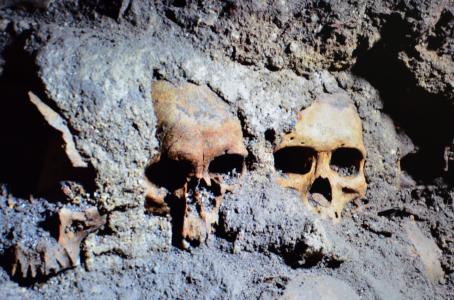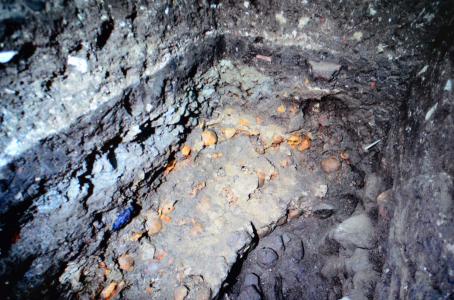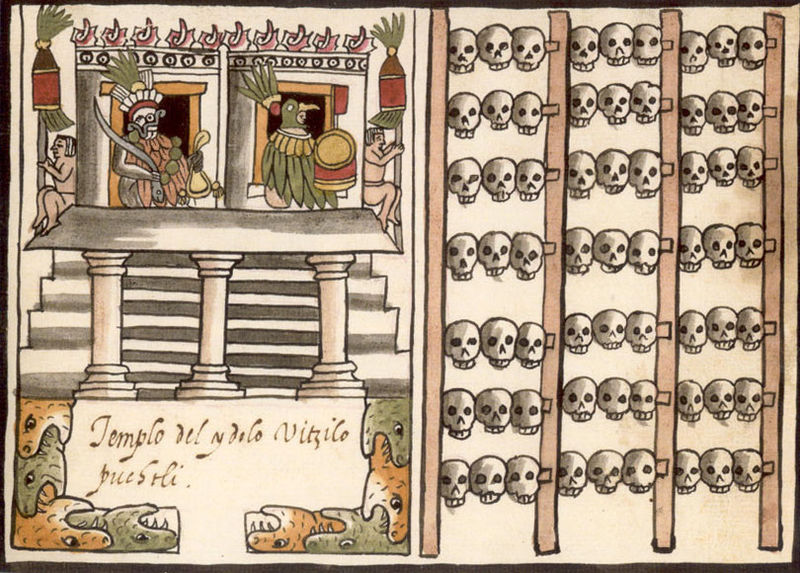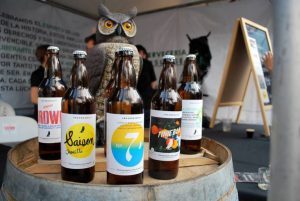Ancient Ruins in Mexico City continue to be rediscovered at the active archaeological site that is the Historic Center. The most recent discovery unveiled the stone platform of the Huey Tzompantli, a wooden rack or palisade where the skulls of war and sacrificial victims were displayed.
The capital’s center is full of archaeological treasures belonging to the Aztec empire. Found on the western side of what was once the Templo Mayor complex in Tenochtitlán, in modern Mexico City, the partially unearthed skull rack was likely built between 1485 and 1502 and may have been about 112 feet (34 meters) long and 40 feet (12 meters) wide.
The discovery was made during the first stage of excavations, conducted between April and June 2014, by specialists at the National Institute of Anthropology and History (INAH) at 24 Guatemala Street, where the platform was buried only two meters deep.
“Due to its location, this is indeed the huey tzompantli, or Great Tzompantli, of Tenochtitlán [the Mexica capital],” said Eduardo Matos, founder of the Templo Mayor project, an archaeological excavation program established in 1978.
The experts estimate that the rectangular platform, almost half a meter high, 34 meters long and 12 wide, was built between 1486 and 1502. So far, 35 skulls have been found. Mostly belonging to young adult men, but also to women and children, several of the unearthed skulls feature holes on both sides. The rack of skulls of sacrificed people used to arranged on wooden poles and displayed to inspire fear and awe. It was likely built between 1485 and 1502 and may have been about 112 feet (34 meters) long and 40 feet (12 meters) wide.
Regarding the Templo Mayor project, work has been constant in the last 37 years. Many buildings have already been located, either partial or complete. It is said that the great ceremonial plaza of Tenochtitlán consisted of 78 buildings, of which more than 45 are now accounted for.” The second stage of excavations at Guatemala Street site is expected to start shortly. The specialists expect to be able to display the huey tzompantli through an archaeological window once excavations are over, but they are unable to say when that might be.
In ancient Mexico, there were once walls built with thousands of human skulls. When Spanish soldiers and explorers made contact with the people of Mesoamerica in the 16th century, they found many new things—including tzompantli, wooden scaffolding used to display human heads. Tzompantli is an Aztec word that means “skull rack,” “wall of skulls,” or “skull banner.”
The huey tzompantli was an impressive, but gruesome, structure that was so big it held tens of thousands of skulls. According to one account described by Diego Durán, a Dominican friar who chronicled Aztec history and culture in The History of the Indies of New Spain (1581), more than 80,000 people were sacrificed to celebrate the dedication of the Great Temple of Mexico-Tenochtitlán and their skulls were used to erect the huey tzompantli. These skulls were changed out regularly and replaced with fresh human heads after human sacrifice rituals.
Apart from their use to display the skulls, Aztecs used to play a game with the losing team being sacrificed. The captain of the winning teams had the task to take the head of the losing team’s captain to be displayed on a tzompantli. In Mesoamerican culture to be sacrificed was to be honored with feeding the gods. Tula, the former Toltec capital, has a well-preserved tzompantli inscription on its ball court.
The process of human sacrifice, strangely, can also be understood as a kind of manual labor. The Aztecs worked in shifts during the human sacrifice rituals because the people tasked with the killing got “tired.” It seems that cutting open dozens or hundreds of chests at once is hard work. From The History of the Indies of New Spain:
“The prisoners were lined up at the tzompantli, the skull rack…the king sacrificed many of the prisoners until he tired. Then Tlacaelel took the sacrificial knife and continued cutting out hearts until he too became tired. After Tlacaelel stopped, the surrogates of the gods continued sacrificing the prisoners until all seven hundred captives…had been killed.”
Although tzompantli is an Aztec word, a variety of skull racks have been recorded throughout Mesoamerica and were built from the 7th to the 16th centuries. Different types of skull racks have also been noted at archaeological excavations in Mayan and Toltec cities. In the Historia verdadera de la conquista de la Nueva España (The True History of the Conquest of New Spain) written in the late 16th century by Bernal Díaz del Castillo (abt. 1498– 1584), a Spanish soldier who traveled with Hernán Cortés during the conquest of Mexico, Castillo describes finding skull racks throughout Mexico:
“…They had many heads hung on some beams from one end to the other, and guarding those bones and skulls were three papas, who, as we understood, were in charge of them. We saw more of this when we got further in land, in all the towns it was like this…”
During an excavation at Tenochtitlán twin city, Tlatelolco, in 1962 archaeologists found 170 skulls with their mandibles still attached and large holes on both sides of the cranium in the temporal and parietal areas. The holes and the alignment of the skulls in groups of five suggested that they were once displayed on a tzompantli.
So far, 35 skulls have been found on the 112-foot-long, 40-foot-wide rack. However, it’s believed that more will be found in underlying levels.
The Aztecs were a Mesoamerican people of central Mexico in the 14th and 16th centuries. After the 1521 conquest of Tenochtitlan, the Spanish founded the new settlement of Mexico City on the site of the now-ruined Aztec capital. The greater metropolitan area of Mexico City now covers much of the Valley of Mexico and the now-drained Lake of Texcoco.
ILUMINA is an interactive sculpture of light and sound fed by the collective energy of people’s hearts.
Art and technology are two faces of human creativity, two that are also closely related, despite the differences they apparently have with each other. What art does on many occasions has been achieved thanks to a specific technical development, a technology whose existence allows the artists to enhance or limit their creative work. Yes, it conditions it, but possibly also encourages it to transcend those limitations.
In this sense, the relationship between one and another human activities could be found in virtually any era, but it is certainly in recent times when technology has a presence, so persistent, somehow so inescapable, that art has been benefited for incorporating it. Both as a resource, an instrument, as part of the examination of contemporary reality, when many of our practices and interactions almost necessarily pass through a technological device.
Thus, somehow the ideal professed by Nietzsche on the need to transform life in a work of art, but this time through art and technology. Somehow the aesthetic sensibility, the discovery of the admirable or the frankly beautiful that any of us can perceive, finds a vehicle, a means of transmission and expression in how art can be magnified through technology.
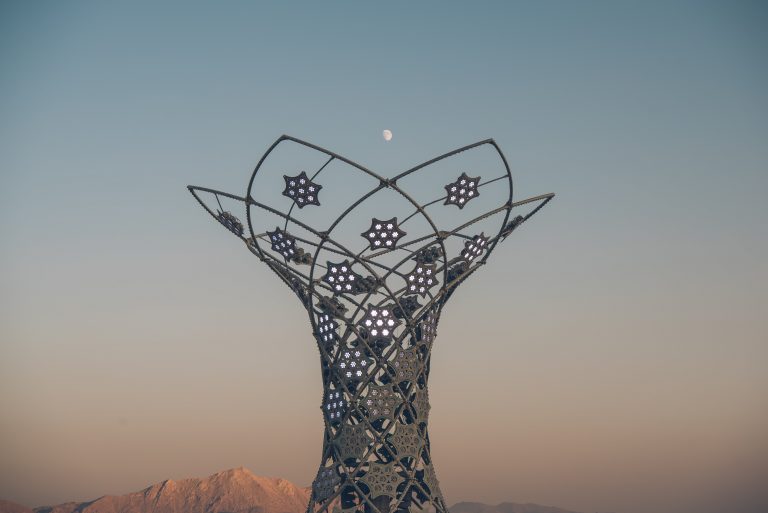
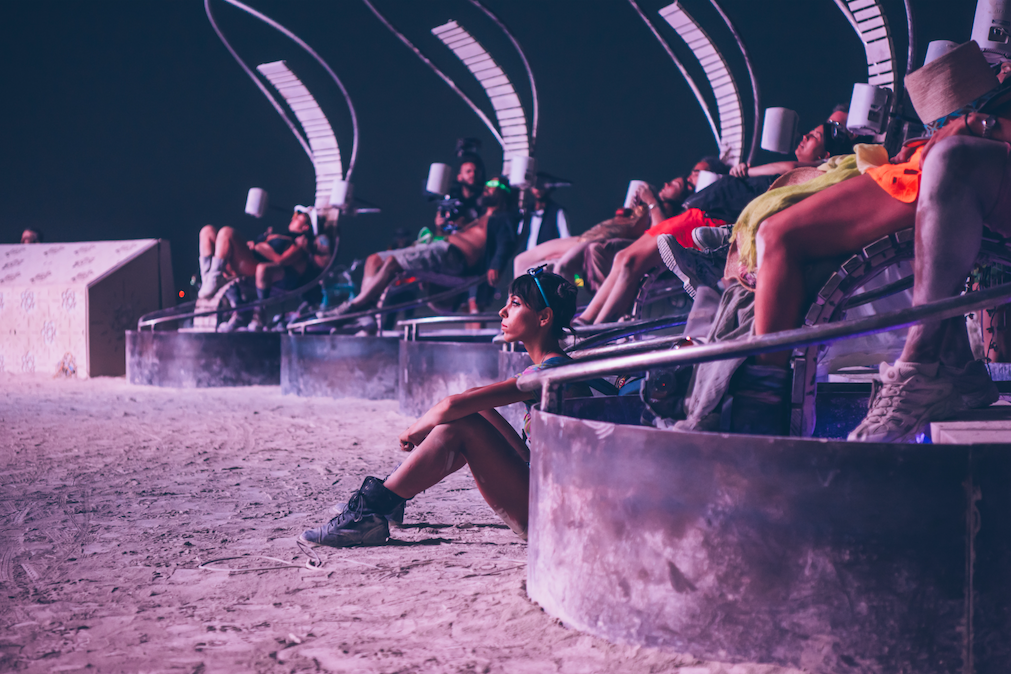
Nowadays, it is becoming more and more complex to achieve high levels of consciousness, and to create a community without being outside of technology, but ww can use it as a tool to improve our sensitive abilities. To the same extent that we depend on technology to survive, it has become part of our lives, even in its most spiritual and even transcendental recesses. Art, now more than ever, demands to be a vehicle to explore different states that bring us closer to the dimensions of the infinite
Ilumina is an installation created by the artist Pablo Gonzalez Vargas, who through a deep exploration with the power of interconnectivity, proposes a method to improve the energy field of the planet. Pablo Gonzalez created a majestic interactive sculpture of light and sound that is activated by the emotional states of people, generating a beautiful light show and a sound landscape where the participants enter a state of coherence and deep harmony with themselves and with each other.
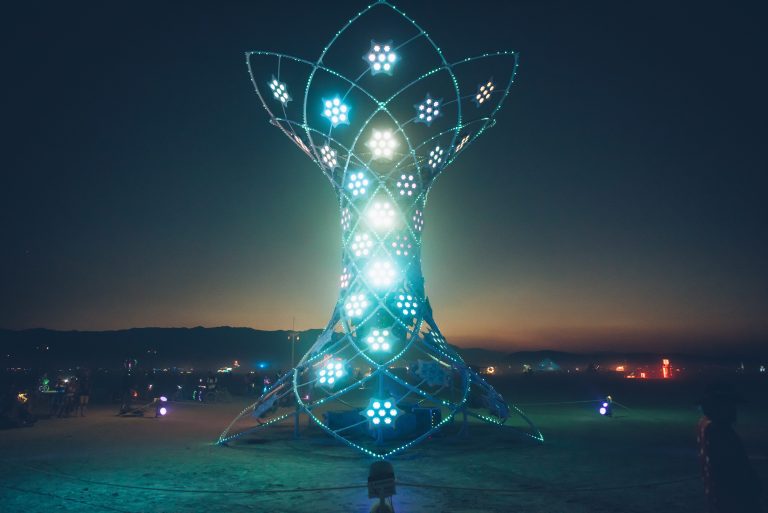

Ilumina is a metallic art monument, completed with aluminum and LED lights that together form an architectural piece full of harmony. The piece of art combines technology with a design of ancient wisdom. Ilumina has a program that responds to external stimuli, being able to shine more while more “coherent” is the group that hosts, generating a unique shared experience.
Ilumina is a chilling visual experience, and the volunteers who participate in the exercise of meditative immersion that lasts three minutes, are transported to a state of coherence and deep harmony with themselves, with their fellow participants and with the cosmos through a patented fusion of modern technology and transpersonal art.
The biometric sensors are connected to the ear lobes of each participant, which measures their unique state of coherence and averages them together. This is how lighting design and moving soundscapes respond to a unique algorithm, a product of HeartMath that uses biometric sensors for personal self-training in the regulation of emotional states where the sculpture becomes brighter to the extent that the users experiment with their emotions.
The team that created Ilumina included about 20 people from different disciplines and contributions. There was a large industrial design team that shaped the exact model that was taken to manufacturing. Marco Kalach worked with an expert manufacturing workshop, because as it is a public use facility in particular events, it had to comply with all the rules, structural regulations and with protection codes. The executive producer of the project was Gaby Vargas, who was responsible for the expertise at HeartMath, and joined by mexican musicians and audio engineers to make the experience of 360 degrees of immersive sound, led by Billy Mendez. The lighting team, directed by Paolo Montiel, coordinated all the programming and lighting design that makes symbiosis with the audio.
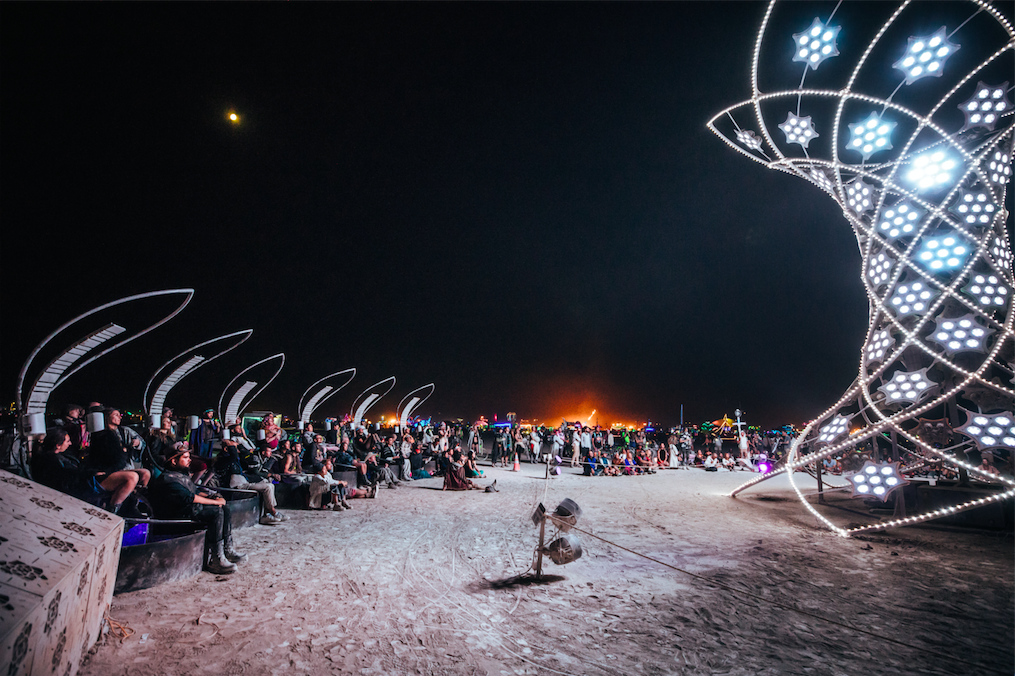
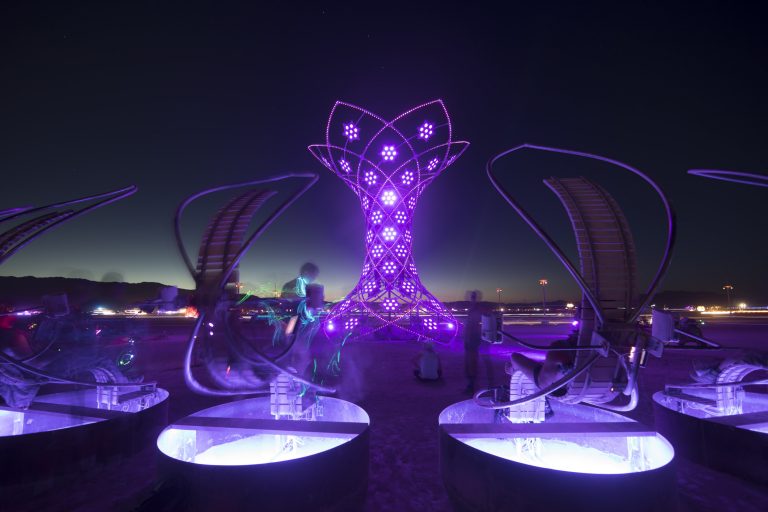
It was at Burning Man 2012, where Pablo Gonzalez Vargas created an art car called Mayan Warrior: a luminescence project and a spectacular audio show featuring pieces by the artist Alex Gray and musical performances by elite artists from Mexico and around the world.
In the penultimate edition of Burning Man, Pablo Gonzalez and his team decided to go a step beyond the great proposal that is Mayan Warrior, by presenting Ilumina, this piece of sacred geometry that radiates not only light but an algorithmic sacrality, it’s as mystical and hypnotic as an art piece can get. The tower of almost 12 meters high illuminated the Nevada desert at the Burning Man Festival 2017, and users managed to enter a mental state full of concentration characterized by a complete absorption, a wonderful moment of loss of the notion of spacetime.
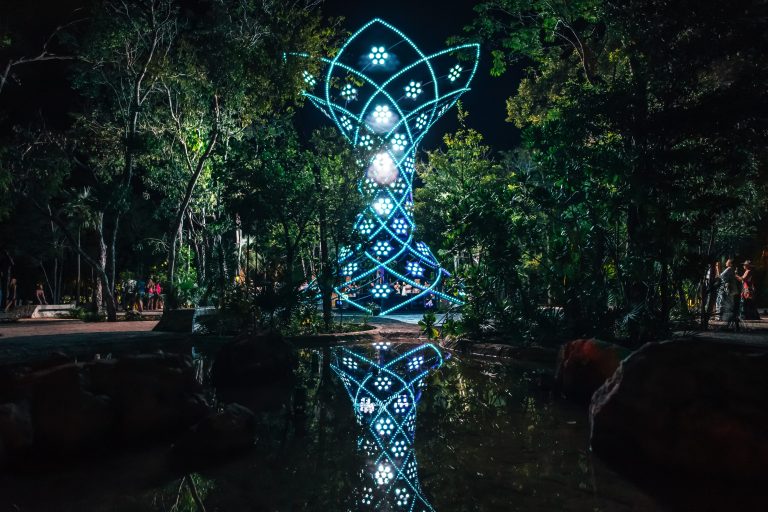
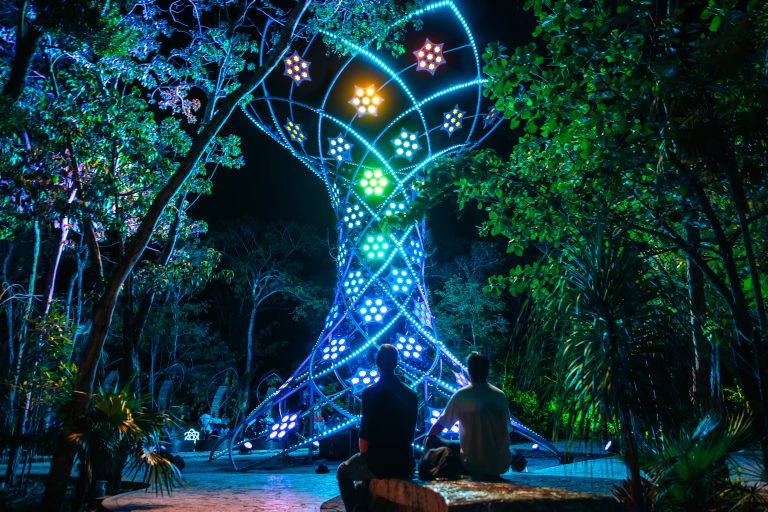
It is expected that later there will be replicas of these sculptures, so that they can reach new locations around the world, and we can experience this amazing spectacle of light and the soundscape that connects us with the profound mysticism that exists in ourselves and that highlights the interconnectivity of our planet with the global energy fields.
Here are some photos of this beautiful project, in which lies the probability of a coherent and luminous future that would be worth living.

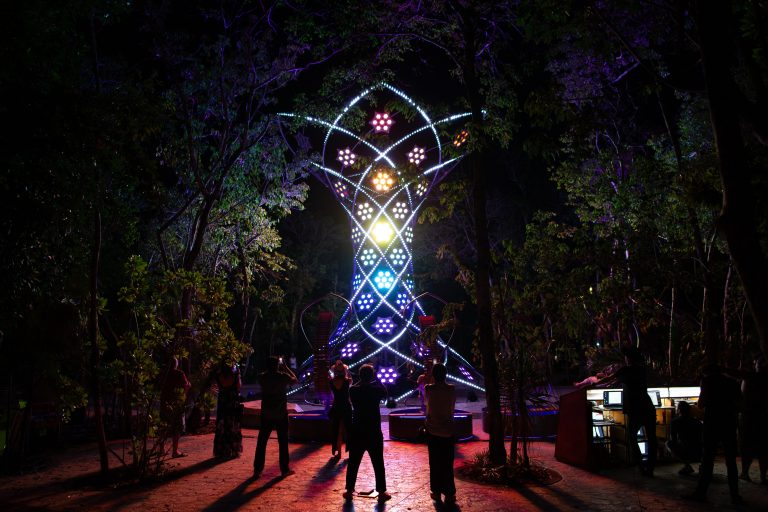

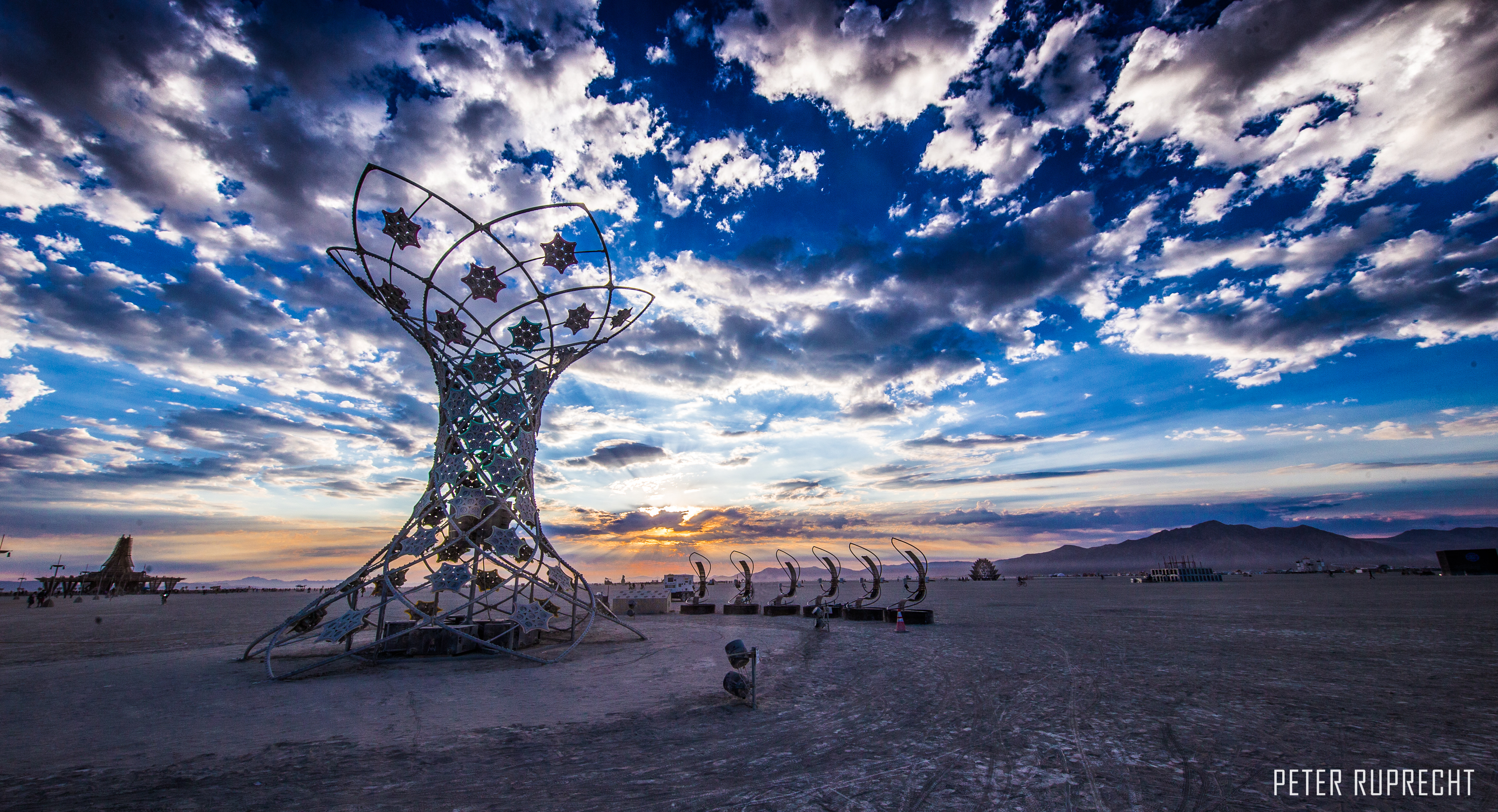
If you want to know more about this beautiful project or about the creative artist and allies that integrate it, visit their social media channels:
Ilumina Art Installation
Sitio web // Facebook // Instagram
Chilangos may cherish their reputation for never reading, but Mexico City libraries present a very contrary picture.
Though the internet makes lots more information available to lots more people, Mexico City libraries have simply not been supplanted. Charged with continually re-inventing themselves, and their places in the public imagination, one can still encounter eras gone by and great historical minds in a library as in few other places.
Knowledge, after all, belongs to everyone. Opening a book, reading it at a study, or just meeting in the silence of one these Mexico City libraries enhances concentration, and provides a welcome respite from everything going on out there in the world.
Of all Mexico City libraries, the oldest were part of the church and one or another of its offshoot organizations. Among these was the Colegio de Santa Cruz de Tlatelolco, founded in the 1530s and surviving today as the Biblioteca José María Lafragua. Most of these ecclesiastical libraries were not truly open to the public, and Mexico had to wait for the National Library of Mexico, inaugurated by Benito Juárez in 1867 to enjoy the benefits of a truly public library system.
The list below is intended to let you enjoy some of that system, too.
José Vasconcelos Library
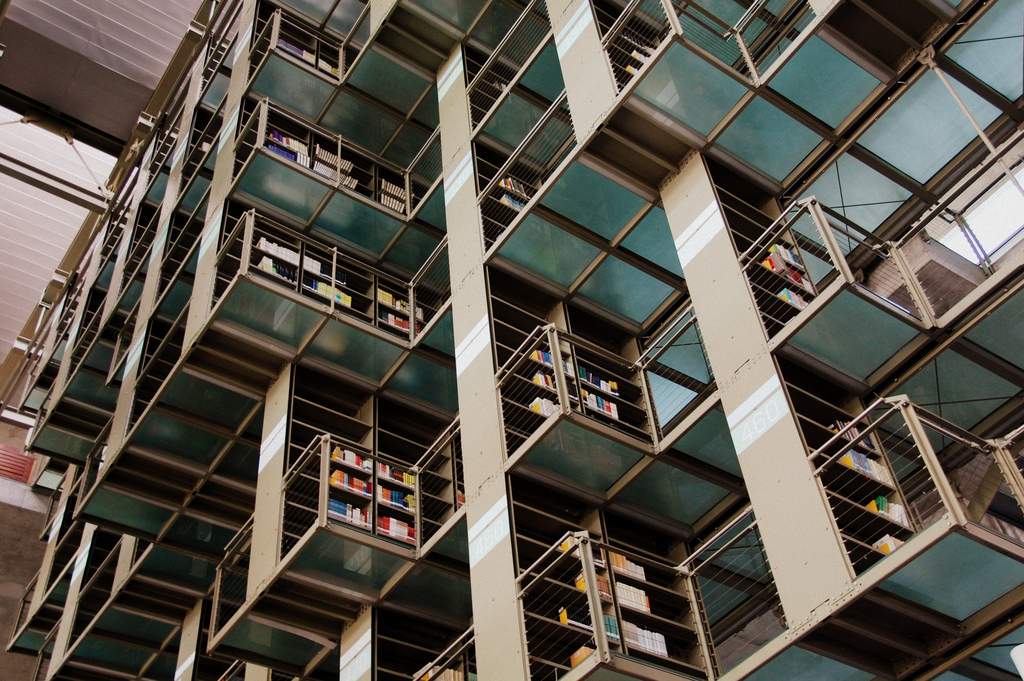
Opened just ten years ago, in 2006, the Vasconcelos is visited by thousands for the sheer spectacle of its innovative design. Graced by the iconic whale from artist, Gabriel Orozco, it’s always a good library for art and visual spectacle. The facade retains something of a colonial appearance, but for sheer scale, and jaw-dropping space, the interior must be experienced.
Address: Eje 1 Norte Mosqueta S / N, Buenavista
Website
UNAM Central Library
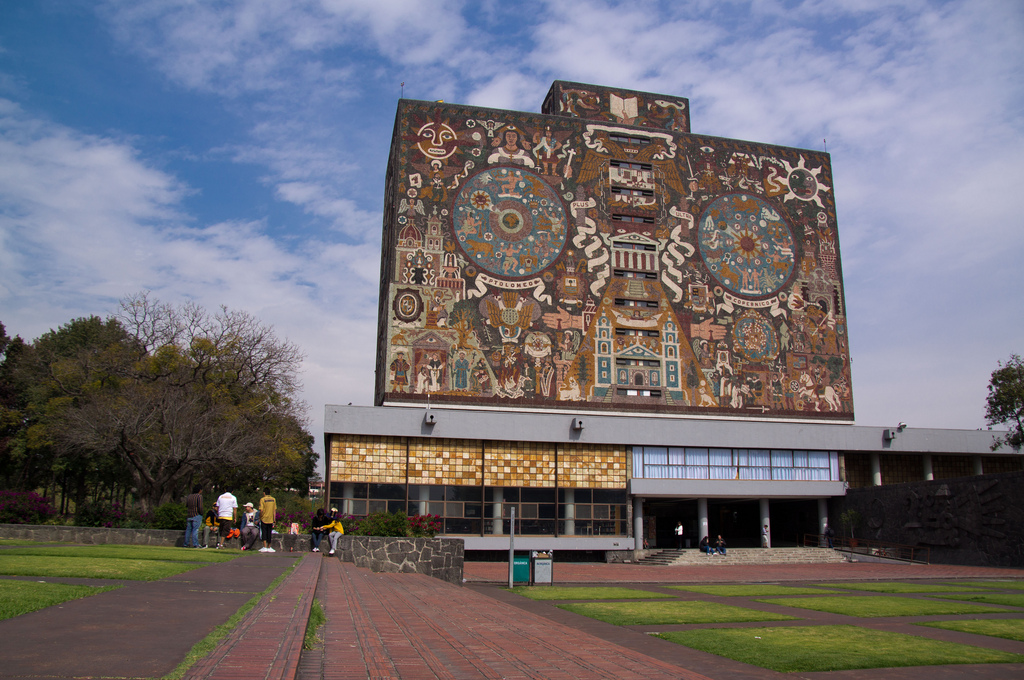
We’ve written a lot about it in these pages, but the UNAM library with the Juan O’Gorman murals remains one of the most outstanding of all Mexico City libraries. As a UNESCO site with some 428,000 volumes in the collection, it’s the biggest in Mexico, but lots of folks visit just to see the facade and the surrounding grounds.
Address: Circuito Interior S / N, Coyoacán, Ciudad Universitaria
Website
National Library of Mexico
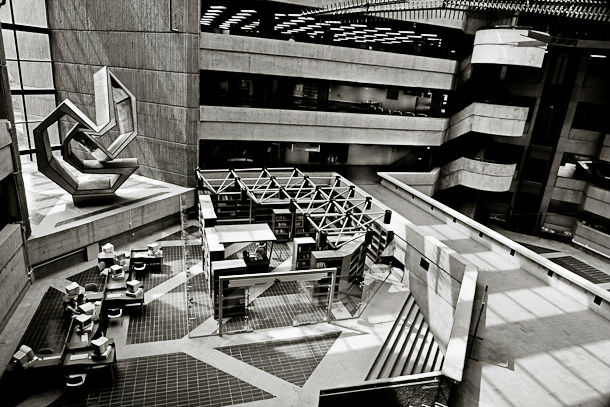
Opened by Benito Juárez in 1867, there’s still a good one million books inside, today administered by the folks from UNAM. Originally located in the San Agustín church in the city center, the current building was opened in 1979. Geometric, and massive, it’s an extraordinary place to visit.
Address: Av. Universidad 3000, Coyocacan
Website
Miguel Lerdo de Tejada Library
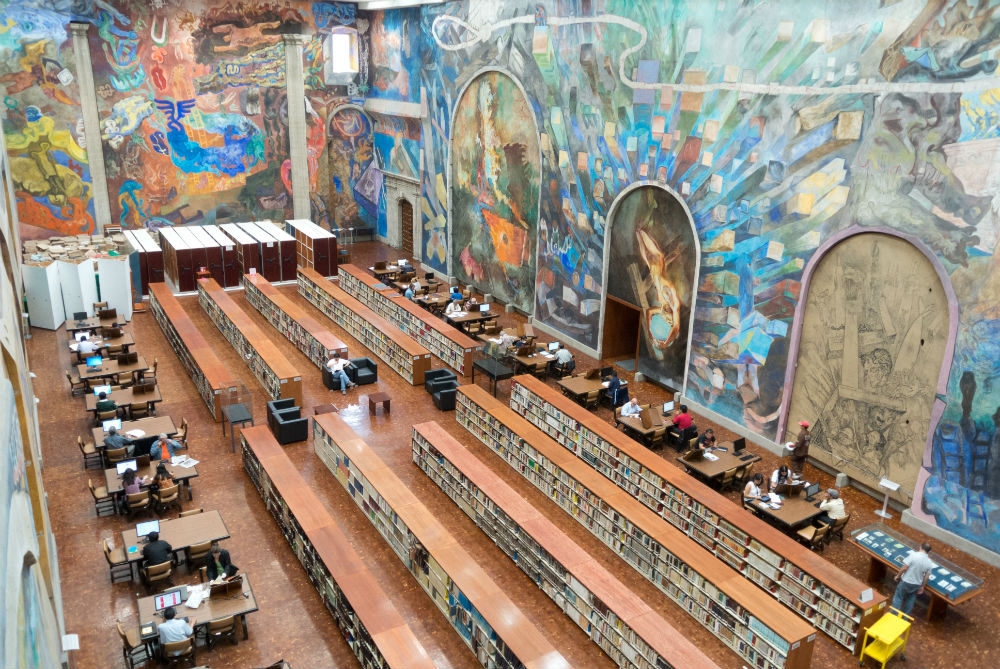
Specializing in economic materials, this collection of some 86,350 books and 114,852 journals is administered by the Secretary of Finance and Public Credit. Founded in 1928, it’s one of the cities true public art spectacles. Inside the main nave of the old Oratory of San Felipe Neri “El Nuevo,” the baroque façade outside is just the beginning. Inside, the murals are futuristic, and not to be missed.
Address: Av. República de el Salvador 49, Centro Histórico, col. Centro Histórico
Library of Congress of the Union
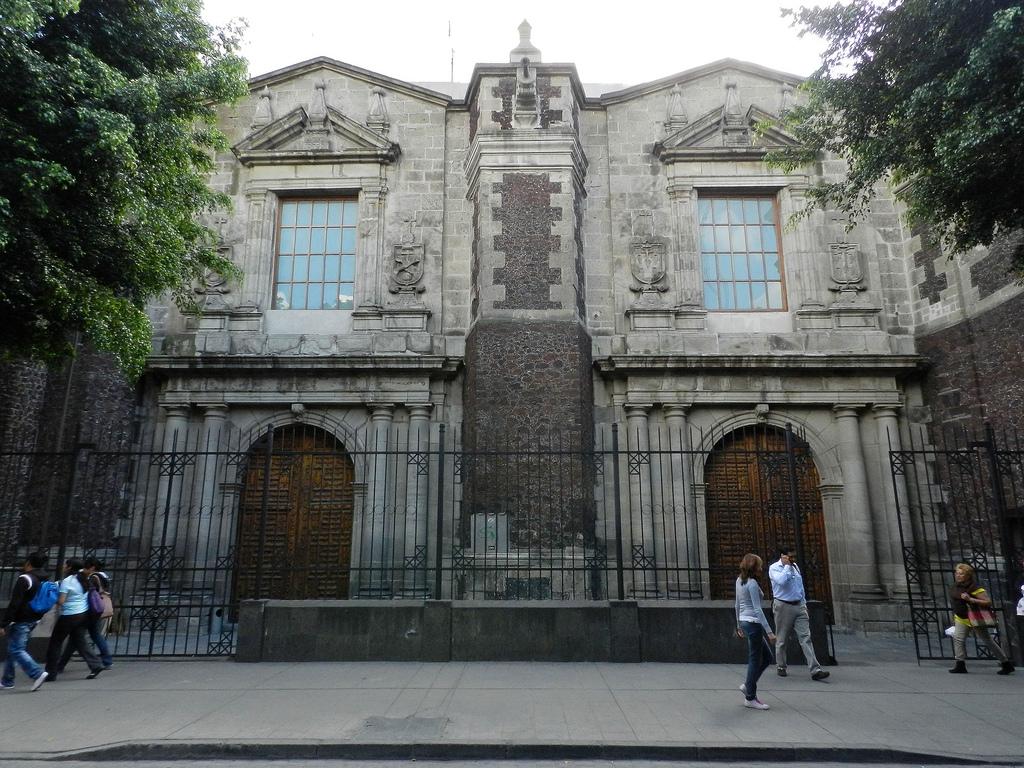
One of Centro’s truly outstanding historical buildings, for centuries it was the convent of the Clarisas from the 16th century. Today it’s something like a “Library of Congress” with a stunning collection of publications and artifacts, but also with a lush, deep, dark intellectual interior, that beckons from centuries past.
Address: Tacuba 29, Centro Histórico
Photographs this page: Flickr – Creative Commons

